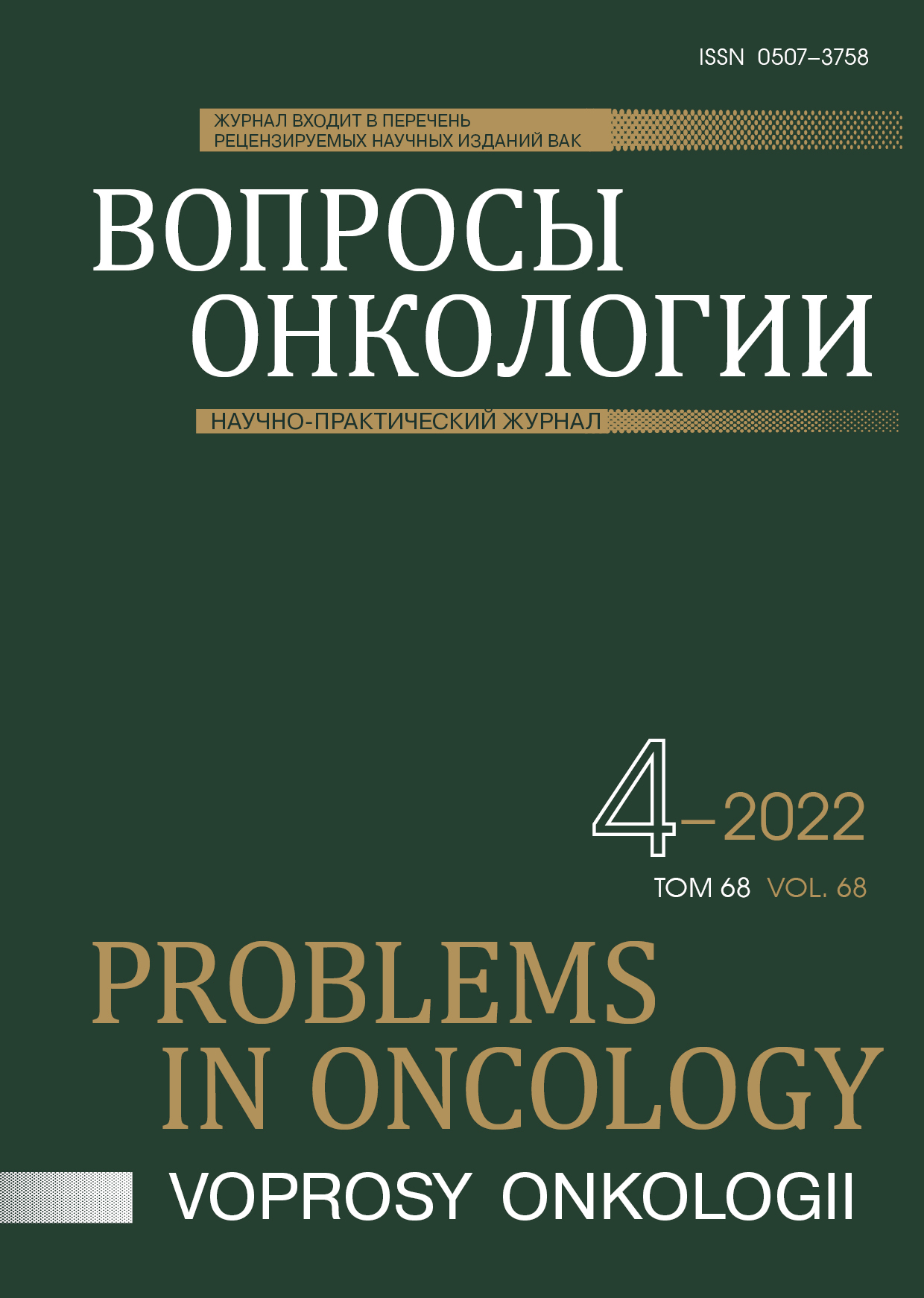Abstract
Purpose. Search for optimal timing of the boost, study the level of doses used and the number of irradiated metastases.
Materials and Methods. In 47 patients with non-small cell lung cancer (n=20) and breast cancer (n=27), with metastatic brain lesions after Whole Brain Radiation Therapy (WBRT) at various times since the end of WBRT, a boost (dose-escalated stereotactic radiosurgery) (SRS) has been provided since January 2014. The prescribed dose for the use of late boost ranged from 10 to 22 Gy with a median of 15 Gy, and for a standard bust immediately after the end of WBRT from 6 to 12 Gy with a median of 12 Gy.
In the group with late boost, a significantly greater number of brain metastases was recorded (r=0.454; p=0.001), less frequent the solitary nature of the lesion was noted (r=0,728; p<0,0001) compared with the standard boost.
The volume of tumor mass at the primary lesion in the two groups was comparable (r=0.072; p=0.632).
Results. As of December 2021, 40 patients (85.1%) died, at the same time, according to our data, only 48.9% of the progression in the central nervous system. After WBRT+SRS, local progression (growth in the bust zone) was noted in 18 patients (38.3%), distant progression (the appearance of new metastasis or carcinomatosis) — in 63.8%. Often the patients had a combined lesions. As a result of long-term observation the median regression of brain metastases after WBRT was 79,9% (95% Cl: 70,7–83,2). Such a serious reduction in the tumor mass allowed bringing the dose in the range from 15 to 20 Gy during the late boost. The number of radiosurgical zones ranged from 1 to 15 with a median of 4 (95% Cl: 2.5–5.0) versus 1 to 4 zones with a median of 1 (95% Cl: 1–1) with a standard boost. The median of local progression with late boost was 40.7 months (95% Cl: 26.3–55.2), Local recurrence was registered in 7 out of 30 patients (23.3%), with standard boost — only 18.0 months (p=0.001).
The median time to local progression at a dose level of ≥15 Gy was 40.7 months (95% Cl: 38.6–42.9), local recurrence was registered only in 4 out of 26 patients (15.4%), at a lower dose level — 18.0 months (p <0.0001), growth in the boost zone was noted in 14 out of 21 patients (66.7%). The Cox Regression Survival Model identified two most significant factors affecting the development of local recurrence. These predictors were dose level ≥15 Gy (OR=0.053; p=0.015) and tumor volume (Vbust) <10 cm3 (OR=0.154; p=0.006). Improvement of local control in the boost zone did not affect overall survival rates in the groups with standard and late boosts (p=0.560) and the frequency of distant progression in the central nervous system (p=0.476).
Conclusion. Late boost can be used for multiple (from 4 to 10) metastatic brain lesions or oligometastases that do not meet the criteria for radiosurgical treatment in size. Applying the maximum dose with the help of late boost is advisable only in patients without extracranial metastasis or in patients with metastatic process controlled by drug therapy.
References
Patil CG, Pricola K, Sarmiento JM et al. Whole brain radiation therapy (WBRT) alone versus WBRT and radiosurgery for the treatment of brain metastases // Cochrane Database Syst Rev. 2017;9:CD006121. doi:10.1002/14651858.CD006121.pub4
Chougule PB, Burton-Williams M, Saris S et al. Randomized treatment of brain metastasis with gamma knife radiosurgery, whole brain radiotherapy or both. 2000;48, Is. 3, Suppl. 1:114. doi:10.1016/S0360-3016(00)80024-3
Andrews DW, Scott CB, Sperduto PW et al. Whole brain radiation therapy with or without stereotactic radiosurgery boost for patients with one to three brain metastases: phase III results of the RTOG 9508 randomised trial // Lancet. 2004;363(9422):1665–72. doi:10.1016/S0140-6736(04)16250-8
El Gantery MM, Abd El Baky HM, El Hossieny HA et al. Management of brain metastases with stereotactic radiosurgery alone versus whole brain irradiation alone versus both // Radiat Oncol. 2014;9:116. doi: 10.1186/1748-717X-9-116
Kondziolka D, Patel A, Lunsford LD et al. Stereotactic radiosurgery plus whole brain radiotherapy versus radiotherapy alone for patients with multiple brain metastases // Int J Radiat Oncol Biol Phys. 1999;45(2):427–34. doi:10.1016/S0360-3016(99)00198-4
Tsao MN, Xu W, Wong RK et al. Whole brain radiotherapy for the treatment of newly diagnosed multiple brain metastases // Cochrane Database Syst Rev. 2018;1:CD003869. doi:10.1002/14651858.CD003869.pub4
Даценко П.В., Беликова А.А., Герасимов В.А. Шкала прогноза краткосрочной выживаемости при метастатическом поражении головного мозга у больных раком легкого и молочной железы // Вопросы нейрохирургии. 2020;84(4):26–35. doi:10.17116/neiro20208404126 [Datsenko PV, Belikova AA, Gerasimov VA. Short-term survival prediction scale in patients with metastatic brain disease caused by lung and breast cancer // Voprosy neirokhirurgii. 2020;84(4):26–35 (In Russ.)]. doi:10.17116/neiro20208404126
Peacock KH, Lesser GJ. Current therapeutic approaches in patients with brain metastases // Curr Treat Options Oncol. 2006;7(6):479–89. doi:10.1007/s11864-006-0023-8
Eichler AF, Loeffler JS. Multidisciplinary management of brain metastases // Oncologist. 2007;12(7):884–98. doi:10.1634/theoncologist.12-7-884

This work is licensed under a Creative Commons Attribution-NonCommercial-NoDerivatives 4.0 International License.
© АННМО «Вопросы онкологии», Copyright (c) 2022
